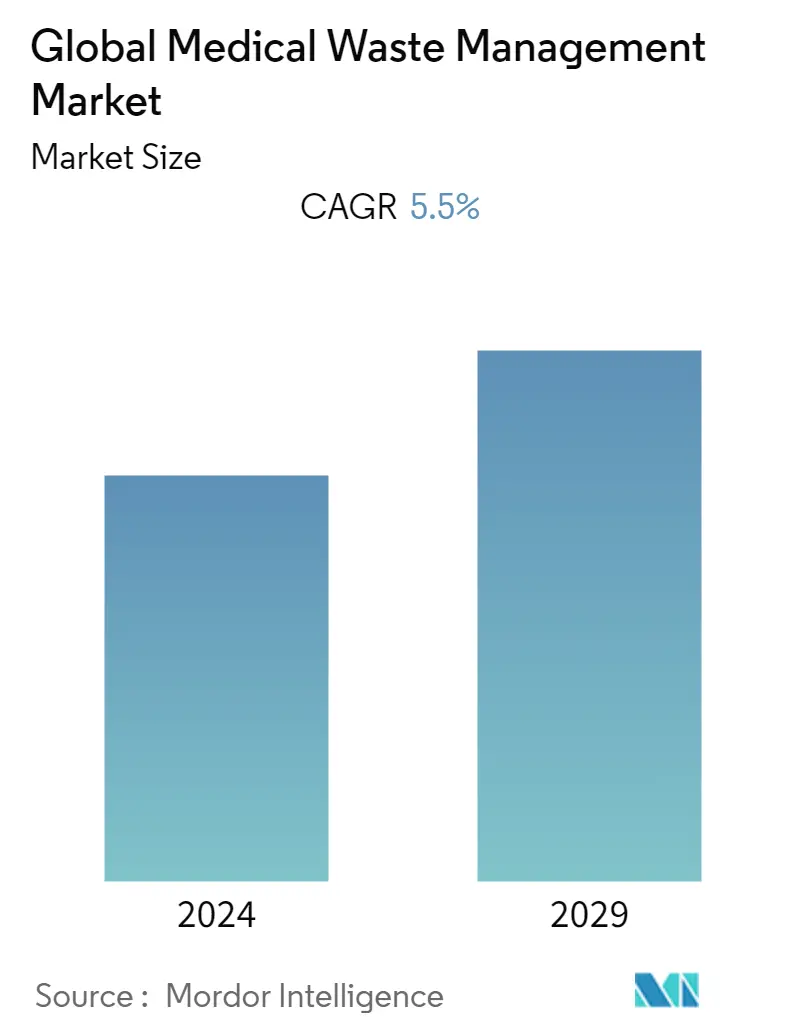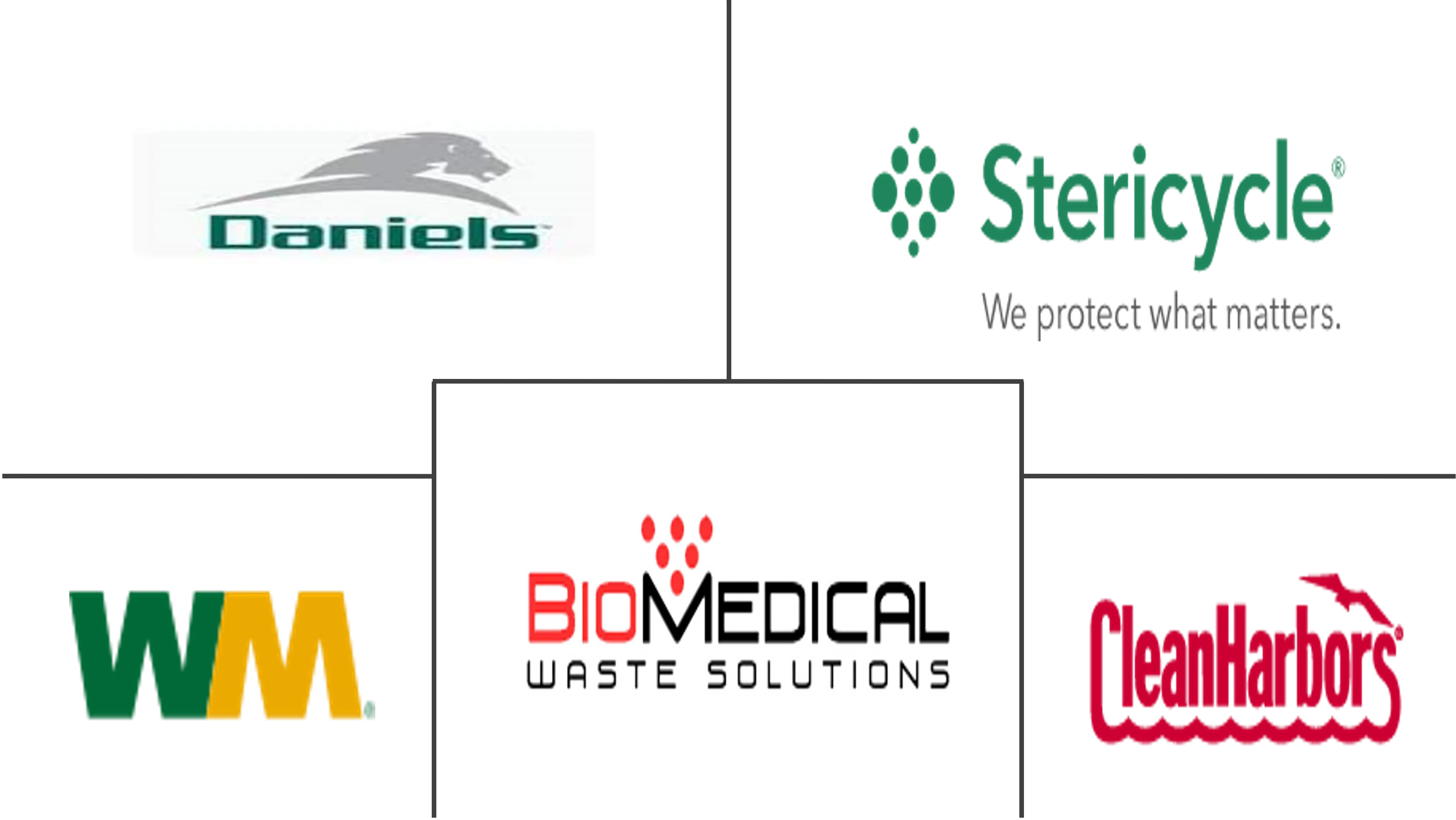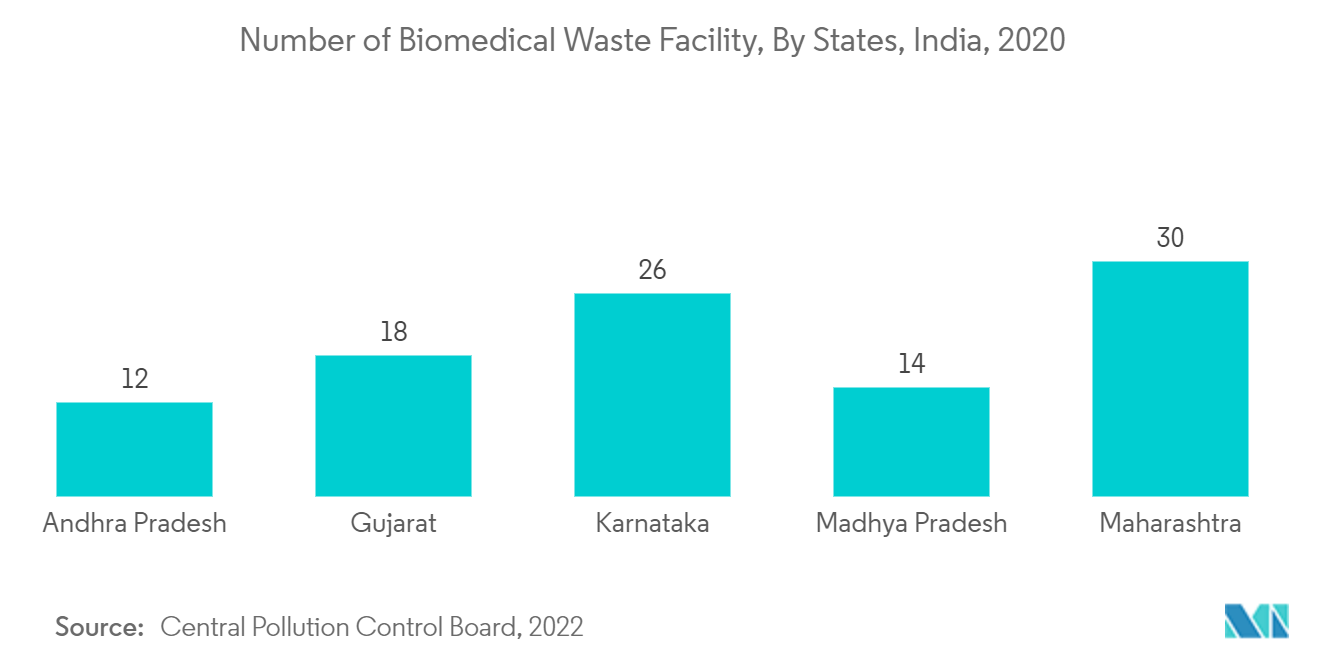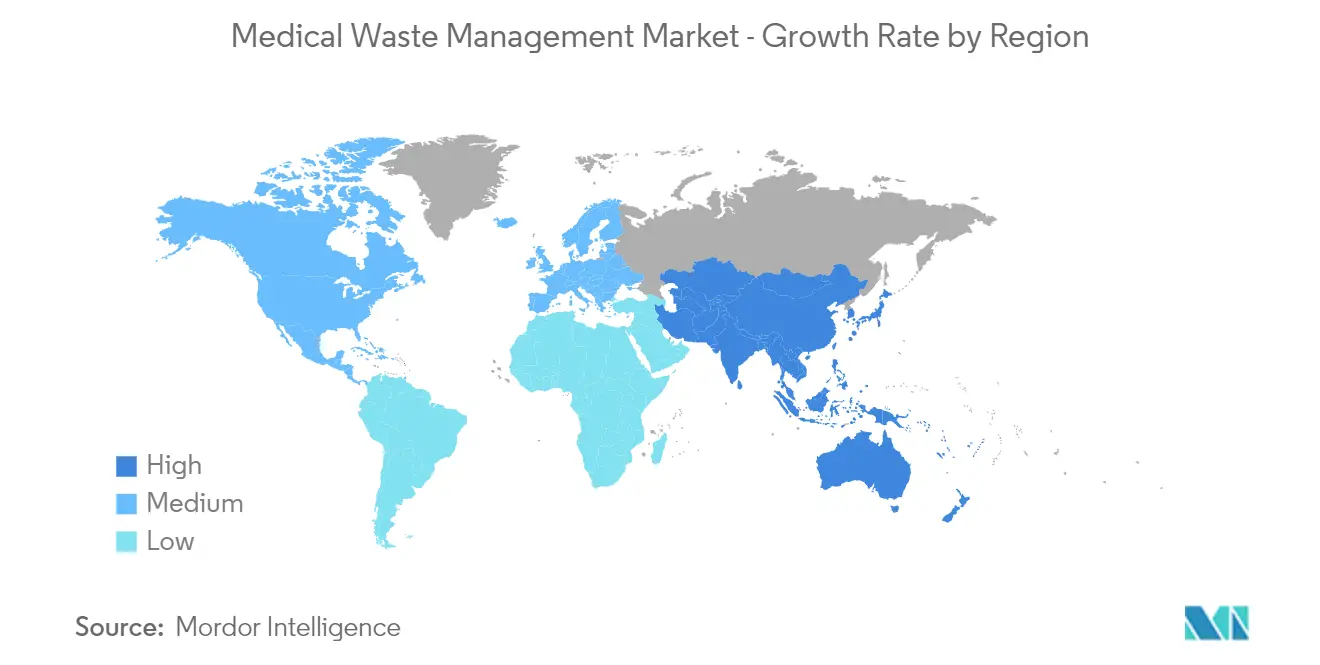Medical Waste Management Market Size

| Study Period | 2019 - 2029 |
| Base Year For Estimation | 2023 |
| Forecast Data Period | 2024 - 2029 |
| CAGR (2024 - 2029) | 5.50 % |
| Fastest Growing Market | Asia Pacific |
| Largest Market | North America |
Major Players
*Disclaimer: Major Players sorted in no particular order |
Medical Waste Management Market Analysis
The Global Medical Waste Management Market is expected to register a CAGR of 5.5% during the forecast period(2024-2029).
Due to the increase in coronavirus-infected populations, the medical waste generated by health facilities has increased tremendously. Special care should be taken when disposing of COVID-19-related medical waste, as it is likely to spread the virus if not incinerated properly. With the growth in medical waste generation amid the outbreak, several authorities worldwide have devised strategies for waste disposal. For instance, in early 2020, the Central Pollution Control Board (CPCB) India provided guidelines for the management, treatment, and disposal of waste generated during the treatment, diagnosis, and confinement of COVID-19 patients. This has had a positive impact on market growth. Additionally, in August 2021, the Chinese government and the United Nations Development Program (UNDP) jointly launched a new initiative in Nepal to help seven hospitals in the South Asian country improve their healthcare waste management systems to better handle the waste generated during the COVID-19 pandemic. Thus, COVID-19 has had a significant impact on the growth of the market.
Population growth worldwide is increasing the number of patients, leading to an increase in the volume of medical waste generated. Thus, with the increase in medical waste, governments around the world are taking new steps to combat the issue. For example, in India, the Ministry of Environment and Forests (MoEF) introduced the Medical Waste Management and Handling Rules, 1998, and the Bio-Medical Waste (Management and Handling) (Amendment) Rules, 2003 to provide official and mandatory guidelines for health care waste management. The Central Pollution Control Board has also issued guidelines on Central Medical Waste Treatment Plans (CBWTF).
Moreover, a growing number of government-sponsored programs are also driving the market for medical waste management. Several government agencies adhere to laws relating to medical waste. These include the Occupational Safety and Health Administration (OSHA), the Centers for Disease Control (CDC), the U.S. Food and Drug Administration (FDA), the Department of Transport (DOT), and the Drug Enforcement Administration (DEA). Additionally, the initiatives taken by the governments of different countries are also propelling the growth of the market. For instance, in August 2021, the Indian government virtually inaugurated a decentralized biomedical waste incinerator at Buxar Municipality, Bihar. The technology developed by Ganesh Engineering Works was selected through the Biomedical Waste Treatment Innovation Challenge launched in June 2020 by the Waste to Wealth Mission.
Furthermore, the advancement in technology is also contributing to the growth of the market. For instance, in February 2022, Envetec Sustainable Technologies Limited launched its GENERATIONS technology. It is a breakthrough cleantech solution that safely treats biohazardous waste and materials, including plastics, glass, PPE, sharp containers, and other general laboratory consumables, on-site at the source. Envetec is one of the pioneers in environmentally friendly, cleantech solutions engineered for laboratories in the diagnostic, pharmaceutical, medical device, and food and beverage industries. With the introduction of GENERATIONS, Envetec became one of the world's first and only cleantech companies with a validated technology providing treatment at the source to eliminate the existing harmful treatment and disposal of biohazardous waste and materials.
Thus, the market is expected to experience growth over time. However, the need to invest heavily due to the demand for high-value equipment and new technological equipment may hinder the growth of the medical waste management market.
Medical Waste Management Market Trends
Incineration Segment is Estimated to Garner the Largest Share in the Medical Waste Management Market
The incineration segment is anticipated to hold a significant share of the market as burning is the most common and preferred method used to dispose of medical waste, although it is not environmentally safe as it leads to global warming. Factors such as convenience and lower capital investments are likely to boost the growth of this segment over the coming years.
Amid the pandemic, several hospitals and healthcare settings considered incineration as one of the best options for medical waste disposal as it restricted the spread of the virus to a greater extent. For instance, according to the World Health Organization's report titled "A global analysis of health waste in the context of COVID-19: status, impacts, and recommendations" published in February 2022, approximately 97% of plastic waste from the COVID-19 trial was burned.
In addition, the introduction of government programs and the introduction of new ventures are projected to boost the market segment's growth. For example, in August 2021, the Indian government introduced a biomedical waste disposal facility in Buxar Municipality, Bihar, India that is capable of handling 50 kilograms of biomedical waste made from cotton, plastic, or similar materials per hour.
Therefore, due to the aforesaid factors, the market segment is expected to grow over the forecast period.

North America is Expected to Hold a Significant Share in the Market and Expected to do Same Over the Forecast Period
The North American region is expected to dominate the market for medical waste management due to the presence of a highly developed health sector and an increase in infectious and chronic diseases requiring advanced medical and surgical resources and treatment. Moreover, many hospitals in the United States have begun the process of recycling used equipment, which is sold back to the hospital for a fraction of the initial cost. Such factors greatly contribute to the regional market's growth.
According to a study entitled "Application of the Sterilization Process for Inactivation of Bacillus Stearothermophilus in Biomedical Waste and Associated Greenhouse Gas Emissions" published in July 2020, the total amount of biomedical waste produced annually increased from 1,362 tons in 2009 to 2,375 tons in 2019. The biomedical waste produced per hospital bed was estimated at 1.19 kg per bed per day. The study also suggested that about 60% of biomedical waste in the United States is incinerated, 37% is disinfected, and some is treated differently. Therefore, the high amount of medical waste produced in the country will increase the need for a variety of medical waste management treatments, which will bolster the market's growth.
Additionally, the initiatives undertaken by the market players are also propelling the growth of the market. For instance, in May 2021, Stericycle and UPS Healthcare entered into a partnership to manage the reverse logistics of medical waste. As per the agreement, Stericycle will help UPS healthcare manage the reverse logistics of medical waste, including waste classification and disposal. Through this partnership, UPS and Stericycle will provide end-to-end logistical support to the healthcare industry.
Thus, owing to the abovementioned factors, the market in North America is expected to project growth over the forecast period.

Medical Waste Management Industry Overview
The medical waste management market is fairly competitive in nature. Medical waste management is one of the biggest challenges being faced by healthcare providers day by day. Other concerns like HIPAA, epidemiology, potential civil litigation, and state and local regulation often complicate it. The major market players in medical waste management are focusing on elaborating their portfolio of services and products in the waste management market. Companies are also adopting various growth strategies, such as partnerships, agreements, mergers, and acquisitions, to strengthen their market presence in the global medical waste management market. Some of the major market players are Biomedical Waste Solutions, Clean Harbors, Daniels, Sharpsart Inc., Stericycle Inc., and WM Intellectual Property Holdings LLC, among others.
Medical Waste Management Market Leaders
-
Biomedical Waste Solutions, LLC
-
Clean Harbors, Inc.
-
Daniels Sharpsmart Inc.
-
Stericycle, Inc.
-
Waste Management, Inc.
*Disclaimer: Major Players sorted in no particular order

Medical Waste Management Market News
- In August 2022, the Government of Japan and the United Nations Development Programme (UNDP) launched a new project to support the national health agencies and other key stakeholders in Bangladesh, Bhutan, and the Maldives to address the unprecedented rise in infectious health care waste caused by the COVID-19 pandemic.
- In March 2022, a new business named MediWaste was launched to handle Bermuda's biohazardous waste. MediWaste is responsible for transporting, treating, and disposing of medical waste through two incinerators specifically designed for the purpose.
Medical Waste Management Market Report - Table of Contents
1. INTRODUCTION
- 1.1 Study Assumptions and Market Definition
- 1.2 Scope of the Study
2. RESEARCH METHODOLOGY
3. EXECUTIVE SUMMARY
4. MARKET DYNAMICS
- 4.1 Market Overview
-
4.2 Market Drivers
- 4.2.1 Increasing Initiatives by Government Authorities
- 4.2.2 Increasing Awareness of Medical Waste
- 4.2.3 Increasing Medical Waste
-
4.3 Market Restraints
- 4.3.1 Technological Advancements
- 4.3.2 High-capital Investments
-
4.4 Porter's Five Forces Analysis
- 4.4.1 Threat of New Entrants
- 4.4.2 Bargaining Power of Buyers/Consumers
- 4.4.3 Bargaining Power of Suppliers
- 4.4.4 Threat of Substitute Products
- 4.4.5 Intensity of Competitive Rivalry
5. MARKET SEGMENTATION (Market Size by Value - USD Million)
-
5.1 By Type of Waste
- 5.1.1 Non-hazardous Waste
- 5.1.2 Hazardous Waste
-
5.2 By Treatment
- 5.2.1 Incineration
- 5.2.2 Autoclaving
- 5.2.3 Chemical Treatment
- 5.2.4 Other Treatments
-
5.3 By Service
- 5.3.1 Collection, Transportation, and Storage
- 5.3.2 Treatment and Disposal
- 5.3.3 Recycling
- 5.3.4 Other Services
-
5.4 By Treatment Site
- 5.4.1 Offsite Treatment
- 5.4.2 Onsite Treatment
-
5.5 Geography
- 5.5.1 North America
- 5.5.1.1 United States
- 5.5.1.2 Canada
- 5.5.1.3 Mexico
- 5.5.2 Europe
- 5.5.2.1 Germany
- 5.5.2.2 United Kingdom
- 5.5.2.3 France
- 5.5.2.4 Italy
- 5.5.2.5 Spain
- 5.5.2.6 Rest of Europe
- 5.5.3 Asia-Pacific
- 5.5.3.1 China
- 5.5.3.2 Japan
- 5.5.3.3 India
- 5.5.3.4 Australia
- 5.5.3.5 South Korea
- 5.5.3.6 Rest of Asia-Pacific
- 5.5.4 Middle East and Africa
- 5.5.4.1 GCC
- 5.5.4.2 South Africa
- 5.5.4.3 Rest of Middle East and Africa
- 5.5.5 South America
- 5.5.5.1 Brazil
- 5.5.5.2 Argentina
- 5.5.5.3 Rest of South America
6. COMPETITIVE LANDSCAPE
-
6.1 Company Profiles
- 6.1.1 Biomedical Waste Solutions, LLC
- 6.1.2 Clean Harbors, Inc.
- 6.1.3 Daniels Sharpsmart Inc.
- 6.1.4 Republic Services, Inc.
- 6.1.5 Stericycle, Inc.
- 6.1.6 Suez Environmental Services
- 6.1.7 US Ecology, Inc.
- 6.1.8 Veolia Environnmental Services
- 6.1.9 Waste Management, Inc.
- *List Not Exhaustive
7. MARKET OPPORTUNITIES AND FUTURE TRENDS
** Subject To AvailablityMedical Waste Management Industry Segmentation
As per the scope of the report, medical waste contains infectious material, and it is the waste generated by healthcare facilities like physician's offices, hospitals, dental practices, laboratories, medical research facilities, and veterinary clinics. Medical waste can contain bodily fluids like blood or other contaminants. Some examples are culture dishes, glassware, bandages, gloves, discarded sharps like needles or scalpels, swabs, and tissue. The Medical Waste Management Market is segmented by Type of Waste (Non-hazardous Waste and Hazardous Waste), Treatment (Incineration, Autoclaving, Chemical Treatment, and Other Treatments), Service (Collection, Transportation, and Storage, Treatment and Disposal, Recycling, and Other Services), Treatment Site (Offsite Treatment and Onsite Treatment), and Geography (North America, Europe, Asia-Pacific, Middle East and Africa, and South America). The market report also covers the estimated market sizes and trends for 17 countries across major regions globally. The report offers the value (in USD million) for the above segments.
| By Type of Waste | Non-hazardous Waste | |
| Hazardous Waste | ||
| By Treatment | Incineration | |
| Autoclaving | ||
| Chemical Treatment | ||
| Other Treatments | ||
| By Service | Collection, Transportation, and Storage | |
| Treatment and Disposal | ||
| Recycling | ||
| Other Services | ||
| By Treatment Site | Offsite Treatment | |
| Onsite Treatment | ||
| Geography | North America | United States |
| Canada | ||
| Mexico | ||
| Geography | Europe | Germany |
| United Kingdom | ||
| France | ||
| Italy | ||
| Spain | ||
| Rest of Europe | ||
| Geography | Asia-Pacific | China |
| Japan | ||
| India | ||
| Australia | ||
| South Korea | ||
| Rest of Asia-Pacific | ||
| Geography | Middle East and Africa | GCC |
| South Africa | ||
| Rest of Middle East and Africa | ||
| Geography | South America | Brazil |
| Argentina | ||
| Rest of South America |
Medical Waste Management Market Research FAQs
What is the current Global Medical Waste Management Market size?
The Global Medical Waste Management Market is projected to register a CAGR of 5.5% during the forecast period (2024-2029)
Who are the key players in Global Medical Waste Management Market?
Biomedical Waste Solutions, LLC, Clean Harbors, Inc., Daniels Sharpsmart Inc., Stericycle, Inc. and Waste Management, Inc. are the major companies operating in the Global Medical Waste Management Market.
Which is the fastest growing region in Global Medical Waste Management Market?
Asia Pacific is estimated to grow at the highest CAGR over the forecast period (2024-2029).
Which region has the biggest share in Global Medical Waste Management Market?
In 2024, the North America accounts for the largest market share in Global Medical Waste Management Market.
What years does this Global Medical Waste Management Market cover?
The report covers the Global Medical Waste Management Market historical market size for years: 2019, 2020, 2021, 2022 and 2023. The report also forecasts the Global Medical Waste Management Market size for years: 2024, 2025, 2026, 2027, 2028 and 2029.
What are the key trends in the Medical Waste Management Market?
The key trends in the Medical Waste Management Market are a) Incineration segment is expected to garner the largest share in the market b) North America is expected to hold a significant share in the market c) Increasing amount of medical waste produced will increase the need for a variety of medical waste management treatments.
Medical Waste Management Industry Report
This comprehensive report offers a deep dive into the medical waste management industry, providing a detailed analysis of key market drivers and market segments. Mordor Intelligence offers customization based on your specific interests, including: 1. Treatment Type: Irradiative, Biological, Microwaving 2. Category: Controlled, Uncontrolled 3. Waste Generators: Nursing Homes, Research Centers 4. Type of Waste: Pathological Waste



